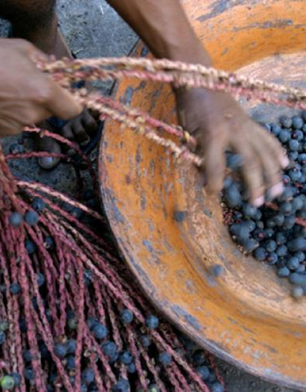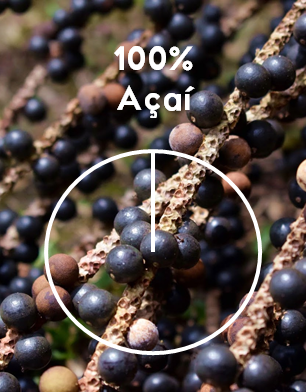An Organic Açaí that is also Ecological
.jpg)
|
We often find ourselves with the choice of choosing local or overseas products depending on their nature. From an environmental perspective, it is always advisable to acquire local goods due to the environmental impact of transport and for defending food sovereignty, but what if the product cannot be produced in our latitudes? There we can choose products from other continents and other climates. And the açaí? Açaí is produced only in the tropical latitude of northern South America, with Brazil and its Amazon area being the main producing areas. Do we have a similar product in Europe that is its substitute? AÇAÍ IS A UNIQUE FRUIT
The acai fruit is very delicate and has nutritional values that not all the fruits can combine. These berries are considered a "super-fruit" for their extra amount of antioxidants, for containing high levels of essential omega 3, 6 and 9 fatty acids, amino acids and dietary fiber. For many nutritionists, these fruits have the highest antioxidant content in the world that help us protect our cells from free radicals and help prevent aging, cardiovascular disease and degenerative diseases. |
"Açaí is produced only in the tropical latitude of northern South America" |
|
|
It is true that the antioxidant content present, for example, in red fruits is also high, but açaí has unique characteristics that make it increasingly appreciated. Which leads us to consider the best way to consume it. Taking into account the importance of respect for nature, which many healthy people and consumers of this berry also share, the first thing is that the açaí be organic, that it comes from sustainable agriculture and that the communities can benefit from its commercialization. Still, even if an acai is eco-sustainable, we are emitting a considerable carbon footprint, just like other tropical food products we import. It is very important to find the best way to choose it to minimize its impact. |
||
NATURAL OR FROZEN AÇAÍ?
There are two ways of presenting Açaí, one that is freeze-dried and the other that is frozen. In both, the first thing to do is select the berries because only those that are at their ripening point can be used. Once chosen, they are pulped, this is the true elixir: the açaí pulp. The pulping also needs to be treated in a few hours since its nutritional and antioxidant values would be quickly lost, also affecting the flavor. In the first method of lyophilization, it is cooled and dehydrated to a point that preserves freshness but cannot deteriorate during storage. In the second method, instead, it is frozen directly. Both processes require multiple repackaging from the processing plant to the final packer. The freeze dried packaging is totally manipulable even at room temperature, however, to keep the açaí frozen, an emulsifier is needed so that it does not lose its texture. A stabilizing base will always help to prevent crystals from forming and increase their creaminess.
Between these two ways the first one is also known as "natural açaí" because it is 100% açaí from dehydration until the consumer mixes it up by making recipes, and the second one is "combined açaí", in which apart from emulsifier it is usually add sugar so that the "açaí ice cream" is tastier and does not lose the fruit taste. Safety in both is guaranteed, but their results are also different in terms of properties. Unlike the traditional production of açaí in Brazil, instead of being frozen, it can be subjected to a pasteurization process to eliminate any type of bacteria, thus keeping the berry's properties and its organoleptic characteristics intact, compared to frozen açaí that loses some peculiarities and that inevitably add colorants and preservatives. |
"Freeze-dried Açaí is considered 'natural açaí' because is used 100% açaí without mixings until the final consumer" |
|
OUR CARBON FOOTPRINT BRINGING AÇAÍ
Every time we find more varieties of high quality organic-lyophilized açaí because transport costs are also reduced in this format from Brazil to Europe, although in the Brazilian country, from whose cities their bowls became popular, frozen açaí is by far the preferred choice . In any case, insisting that not everything organic is always ecological, the biggest problem lies in transportation and conservation, from pulping to the final consumer.
The transport of lyophilized açaí is done like other fruits and vegetables, as well as medicines, in refrigerated compartments whose temperatures range between 0° and 8°, ensuring that there are no heat spikes and then, once it enters the retail chain, it can be stored at room temperature. On the other hand, what is the environmental impact of bringing frozen products from Brazil at a temperature of -12° to -20°? Frozen açaí requires much more energy for its maintenance since its cold chain can never be broken until its moment of consumption. In this case it is of little use to say that an organic fruit product is sustainable because its own frozen format makes it highly polluting from the origin to our table. They are different textures and it is clear that they weigh the years of açaí tradition that they recommend us from São Paulo or Rio de Janeiro, but really, if we Europeans want to consume sustainable Brazilian açaí in a conscious way, it is better to powder it and freeze it in our houses or restaurants. Every action has an impact, so let's reflect on an organic diet from start to finish. |
"Frozen açaí requires much more energy for its maintenance since its cold chain can never be broken until its moment of consumption" |






.jpg)
.jpg)

.jpeg)

Comments
Leave your comment